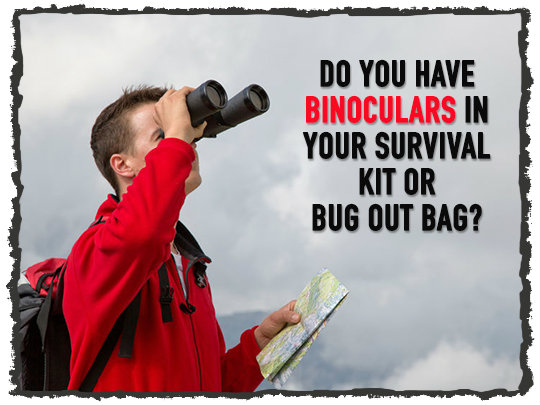
Binoculars allow you to view threats and/or to view situations that may turn threatening from a safe distance. Use them to gather intelligence and for spotting game as well.
The so-called sports glasses that you would take to a ball game are sometimes called binoculars, but they are not ideal for survival situations. They will help magnify at short distances in optimum light, but do not provide clarity and most importantly, they are not designed for rough handling.
Size, Durability and Magnification Are Important
Binoculars to signify magnification and diameter will have two numbers that are separated by an “X”. Two examples would be, 7 x 42 or 10 x 25. The seven and 10 would be the magnification and 42 and 25 would be the diameters.
Binoculars with a magnification of seven for example will make an object look 7 times bigger or seven times closer. In other words, an object 70 yards away will look like it is only 10 yards away when using a seven magnification.
As a rule, low magnification provides a wider field of view and this does make it easier to keep the optics steady on whatever you are viewing. Even though a magnification of 10, 12 or higher is available, six, seven, and 8-power binoculars are easier to use and in many cases more practical for field use.
Keep in mind you may be viewing when in the prone, standing or sitting position, so your hands/arms will not always be supported. You want to be able to maintain the focus on what you are viewing with as little effort as possible.
Lens coating is very important and typically, a quality pair of binoculars will be coated to reduce reflection and to increase the amount of light captured by the binoculars. More light means more clarity and this goes back to magnification and diameter. The bigger the diameter (lower magnification) means an increase in light and thus better clarity, even though the magnification is less.
Binocular models today are more compact and yet provide better optics than older models that were rather large and heavy. Today you can buy a pair that can be folded up and put in a pocket or they can be attached to or placed inside your backpack and most come with neck straps. Keep in mind you do get what you pay for, so do not skimp on quality because the cheaper models may very well let you down in the field.
You do not want binoculars that allow moisture inside the lenses. This of course will cause the lens to fog, and may damage the inner components. Most binoculars will have a rubberized coating and will provide some water resistance but unless they state they are waterproof, their performance can be affected by dew, rain, fog or snow.
Some of you may be thinking, “I will just use my scope for long range viewing”. You can do this of course, but that means you have to remove the scope or shoulder the weapon for viewing and in some cases, this may not be ideal especially if you have to climb a tree or get on a buildings’ roof for greater viewing range.
In an extreme survival situation, you can use the magnification lenses for fire starting and of course, the lenses could be used as a signaling device as well.
Keep in mind if you want concealment the lenses will reflect light so take precautions and make use of natural and manmade camouflage.
You can buy night vision binoculars and even ones that will take digital photographs. The cost is considerably higher of course when you start adding options. Decide what you will be using the binoculars for and purchase accordingly.
Remember, most night vision binoculars are only to be used in darkness. You can damage the optics if they are used in strong light. Some higher quality ones will have an automatic switch that protects the device and certain models do allow daytime use, so you do not have to carry two pair.